Canon S Rangefinder Camera
A Description of this model produced 1938-1945
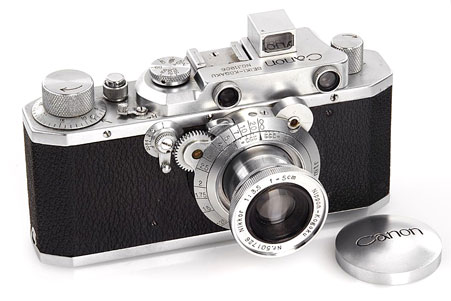
Canon S of 1939
Introduction of the Canon S
In October 1939, to expand the slow moving sales of the Canon Hansa, the Precision Optical Industry Co., Ltd. - 精機光学研究所 - introduced its first new model: the Canon S or 'Standard' model. Production of the Canon Hansa ended in 1940, while the Canon S continued through WW2, but at a reduced level.
Canon S Characteristics
The Canon S was in most of its construction similar to the Canon Hansa. The changes made were intended to make use more easy, and attractive to users. First, slow shutter speeds of 1 second, 1/2 second, 1/4 second, 1/8 second and 1/20 second were added on a separate dial, located on the front of the camera. Previously, 1/20 second was the longest shutter exposure offered on the Canon Hansa. Also, a 'bulb' exposure marked 'Z' was added, but no time exposure setting.
The slow shutter speed dial had a lever attached to make adjustment easier.
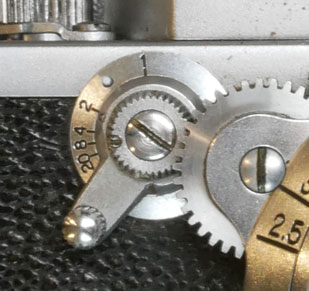
Canon S slow shutter speed dial, with lever
Also, the film frame counter was moved from the front of the camera - where in the case of the Hansa, it had interfered with the photographer's grip of the camera - to the top, underneath the film advance knob, next to the shutter release.
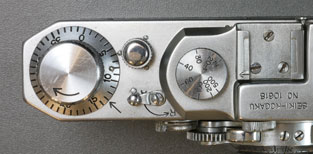
Canon S film counter
Also, the top structure which enclosed the rangefinder was expanded to the fast shutter speed dial in a superstructure shape similar to the Leica II of the 1930s.
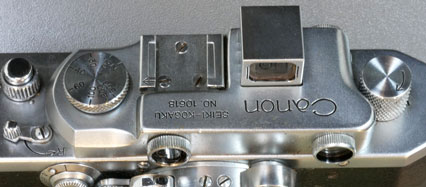
A button was located on the Nikkor focusing mount just below the rangefinder window which released the lens from being locked at infinity.
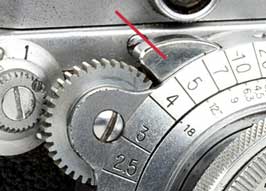
The camera continued to feature a Nikkor 5cm f3.5 lens, bayonet mounted into a Nikkor focusing mounting. A Nikkor 5cm f2.8 was also an option as shown in the beautiful Canon S below:
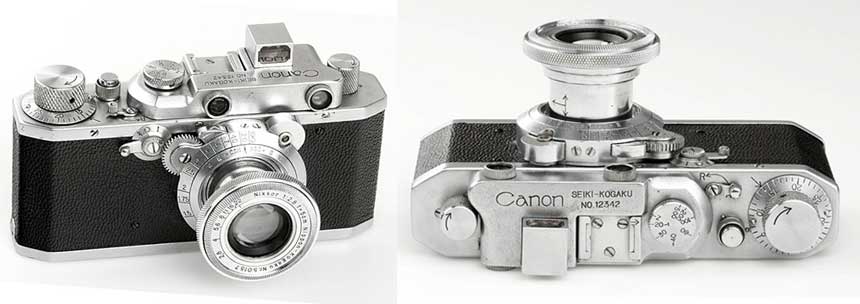
Canon S with Nikkor 5cm f2.8
A Nikkor 5cm F2.0 was also offered as, but less frequently pruchased (see below). The 5cm f3.5 lens was the lens most often sold 2.
Canon S with Nikkor 5cm f2.0 lens
Many (perhaps more than 100 2) Nikkor 5cm f2.0 lenses were equipped during World War II on Canon S bodies.
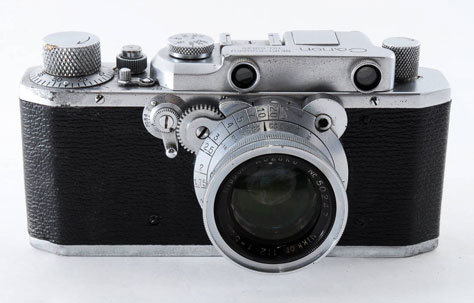
Canon S with Nikkor 5cm f2.0 lens
Unlike the Nikkor 5cm f3.5 and the Nikkor 5cm f4.5 which were made entirely from Japanese-produced glass melted at Nippon Kōgaku, the Nikkor f2.0 used special Schott barium glass imported from Germany. 20 The Nikkor 5cm f2.0 was of 6 elements in 2 groups, as was the Zeiss Sonnar. It is interesting that later tests of the Nikkor 5cm f2.0 found this lens superior in performance to the Zeiss 5cm f2.0 Sonnar on which it had been modeled. 20
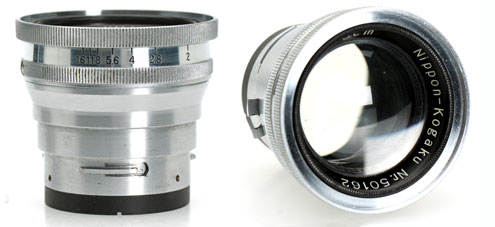
Early Nikkor 5cm f2 lenses had the f-stop setting inside the outer lens ring, but most later lenses had the f-stop setting around the lens body ring, as shown in this photograph.
Canon S with Serenar 5cm f1.5 lens
During 1942-1945, several thousan Canon S bodies were fitted with a Serenar 5cm f1.5 lens.
Peter Kitchingman 2 wrote:
"The Seiki-Kogaku R-Serenar 5cm f1.5 lans was probably the first lens that Canon produced in significant numbers between 1943 and 1945."
These lenses were intially without diaphrams and used with X-ray cameras during the war. However, some were converted with f-stop diaphrams such as the camera shown below.
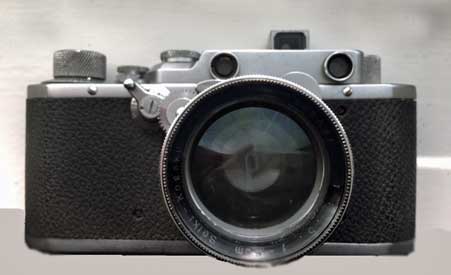
A war-time Canon S fitted with a Serenar 5cm f1.5 lens.
Production of the Canon S
Production of the Canon S began in October 1938 and continued into the early years of World War 2. First sales seem to have been in January 1939.1 Most bodies were sold with a Nikkor 5cm f3.5 collapsible chromium lens, although a Nikkor 5cm f2.0 was also offered. The f2.0 lens is illustrated below.
Peter Dechert estimates that about 1,600 Canon S units were produced, with most crafted prior to the start of the war years in 1939. All these were carefully built by hand, one-by-one by a single assembler. 1
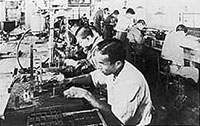
Canon camera production in 1938
By 1939, about 40 Canon S cameras were produced per month. However, beginning 1940-1941, all Japanese manufacture was concentrated on war materials, and no cameras were sold to the public. Peter Dechert estimated that only a few hundred Canon cameras were produced 1943-1944 - all for the military - and perhaps none in 1945.
Examples of Canon cameras for the military include Canon S cameras produced with 20-100 going to the Imperial Navy. Examples of the Canon S with Imperial Navy markings are shown below:
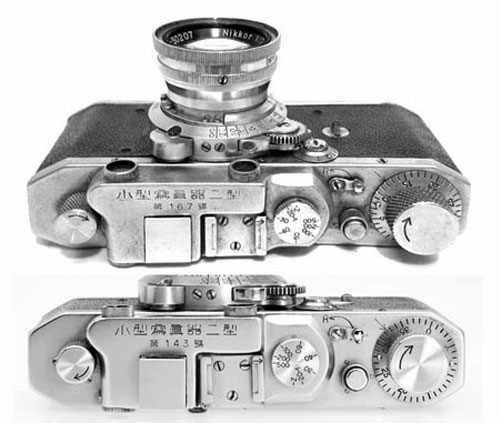
Canon S cameras for the Imperial Japanese Navy marked with Navy serial numbers 143 and 167
Several of the Canon S models for the Imperial Navy are known to have been fitted with the Nikkor 5cm f2.0 lens - such as the model 167 shown above.
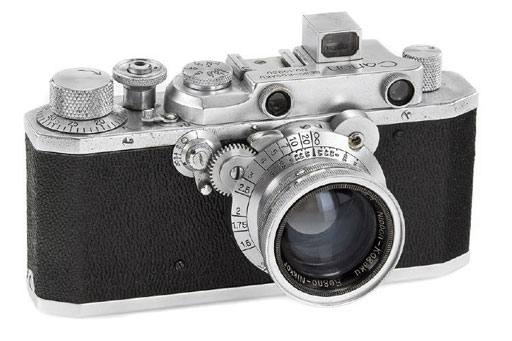
A Canon S of 1942 with the rare Regno-Nikkor 5cm f2.0 lens in base number 10930. This lens indicates the camera-lens combination was produced during World War 2 with this fast lens designed for military use.
There were further small numbers of Canon S cameras assembled in 1943 and 1944 for journalists as well as the military, but with no further commercial sales to the public. 1. So 1944 was the final year of the Canon S - a camera which had established Canon as a successful maker of a quality 35mm camera.
You can click on the links in the table below to consult these pages of the canonrangfinder.org site.
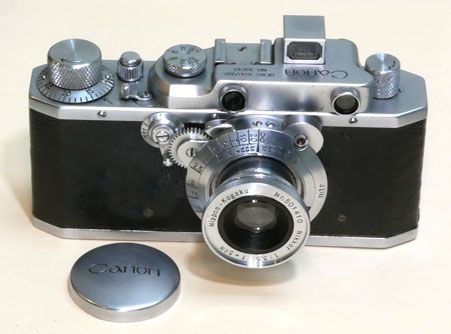
1939 Canon S with 5cm f3.5 white face Nikkor lens in the Nikkor bayonet focusing mount.
| Navigation: Click Below to Jump to Desired Subject Page | ||
|---|---|---|
| Canon Rangefinder Cameras - 1 | Canon Rangefinder Cameras - 2 | Canon Rangefinder Lenses |
| Canon S | Canon IVSB2 | Canon 19mm |
| Canon J | Canon IIS2, IID2, IIF2 | Canon 25mm |
| Canon NS | Canon VT, Canon L2 | Canon 28mm |
| Canon JS | Canon L1, L3 | Canon 35mm |
| Canon J-II | Canon VT Deluxe | Nikkor 50mm |
| Canon S-II | Canon VL, VL2 | Canon 50mm |
| Canon IIB | Canon VI-L, VI-T | Canon 85mm |
| Canon III, IIC, IV | Canon P | Canon 100mm |
| Canon IIIA, IVF, IVS | Canon 7 | Canon 135mm |
| Canon IIA, IID, IID1 | Canon 7s | Canon 200mm-1000mm |
| Canon IVSB | Minolta Rangefinders | Minolta Lenses |
| Canon IIF, IIS | Other Rangefinders | other M39 lenses |
| Go to canonrangefinder.com home page | ||
Any additions or corrections to these pages would be welcome simply by contacting this site as shown at the foot of this page .
Footnotes:
1 Dechert, Peter. Canon Rangefinder Cameras 1933-1968. Hove Collectors Books. West Sussex, United Kingdom. 1985. ISBN 0-906447-30-5.
Peter Dechert's book is the most important expert source of information regarding Canon Rangefinder Cameras.
2 Kitchingman, Peter. Canon M39 Rangefinder Lenses 1939-1971. A Collector's Guide. Published by Peter Kitchingman. Perth, Australia. 2008. ISBN 978-0-646-48144-9.
Peter Kitchingman's book is the definitive study of the more than three decades of M39 format camera lenses developed for Canon Rangefinder Cameras.
3 Nostalgic Canon Camera Book. 懐かしいキヤノン EI Publishing Co. Ltd. Tokyo, Japan. June 2003.
Peter Kitchingman's book is the definitive study of the more than three decades of M39 format camera lenses developed for Canon Rangefinder Cameras.
4 "Canon Camera Museum" history website. https://global.canon/en/c-museum/history/ published by Canon, Inc. accessed in 2019.
5 Rajner, Hans P. (author), John Wade (editor). Leica Copies. Classic Collections Publications. London, UK. ISBN 13: 9781874485056
Hans P. Rajner's book is an excellently detailed and carefully researched study of camera from around the world which used the Leica M39 lens mount and the same lens to film plane distance.
7 Dechert, Peter. Canon Single Lens Reflex Cameras 1959-1991. Historical Camera Publications. Yakima, Washington. 1992. ISBN 1-879561-04-2.
8 Tomlinson, Shawn M. The Film Photography Book. Lulu Pulbications. 2016. ISBN: 9781365263972
9 Sartorius., Ghester. Identifying Leica Lenses. Classic Camera 19. Tokyo, Japan. 2001. ISBN 4-257-12029-0
10 website http://www.nicovandijk.net/rflensmatrix.htm consulted 2019.
11 O'Reagan, Douglas M. Allied Exploitation of German Science after World War II. Johns Hopkins University Press. Baltimore, Maryland. 2019. ISBN 9781421428888
12 website www.canonrangefinder.servehttp.com consulted 2008.
13 Minolta expert Andrea Aprà has posted information on minoltarangefinders group and other groups and further detailed information by email. (thanks Andrea !)
14 website http://www.collection-appareils.fr/objectifs/ consulted 2019.
15 Small, Marc James. Non-Leitz Leica Thread-Mount Lenses. Wittig Books. Hückelhoven, Germany. 1997. ISBN 3-930359-47-2.
16 the Nikon Corporation website: https://imaging.nikon.com/history/ consulted 2019.
17 p 152. Ray, Sidney F. Photographic Lens ISBN 9780240510323
18 website http://www.rokkorfiles.com/Lens%20History.html accessed 2019
If you have any comments or questions about this Canon Rangefinder site, please e-mail me (Larry Huffman) at e-mail address: [email protected]